When 'Precision' Bombing Really Isn't: The Evil, the Grotesque and the Official Lies
[with 5 intermezzos]
by Marc W. Herold
Departments of Economics and Women's Studies
Whittemore School of Business & Economics
University of New Hampshire
"So far, the liberators have succeeded only in freeing the souls of the Iraqis from their bodies"
- George Monbiot1, The Guardian, April 1, 2003
"We had a great day. We killed a lot of people. We dropped a few civilians, but what do you do? I'm sorry...but the chick was in the way."
- U.S. Marine Sgt. Eric Schrumpf2, New York Times, March 29, 2003
POSTED APRIL 8, 2003 --
Since my previous essay3, U.S.-U.K. bombing of Iraq has wreaked widespread carnage, utterly discrediting any notion of careful targeting and 'precision' strikes. Through Friday, March 28th, U.S. bombs and missiles had killed about 450 Iraqi civilians, injuring at least 1000. Well over 800 Iraqi civilians died under U.S. projectiles since the start of the war, that is, more than 50 per day [see Table 1.]. In the week since March 28th, U.S. "precision" projectiles have hit a vegetable market, numerous homes, markets, a hospital, a trade fair, telephone exchanges, a bus, farms, a grain silo, a street outside an emptying mosque, the lawn of a women's university, etc.
Through April 1st, 700 cruise Tomahawk missiles had been fired and 8,000 bombs had been dropped.4
Intermezzo #1. Commander Jeff Penfield of a F/A-18 Super Hornet aboard the USS Abraham Lincoln after a Friday of bombing Baghdad with 1,000 lb. laser-guided 'precision' bombs, reflected,
"It was exhilarating...It was all nice and calm in the city...[but] once those bombs hit all hell broke loose. I bet we saw 15 SAMs. About three or four up our way so we had to defend a couple of times. What I felt more than anything was exhilaration."5
U.S. commanders and the pilots say they are taking great pains to limit casualties in their efforts to overthrow President Saddam Hussein. On the receiving end, Iraqi officials said over 50 civilians were pulverized by a blast at a busy marketplace in northwestern Baghdad on Friday.
Wherein lies the truth? Rageh Omaar of the BBC in Baghdad provides the answer:
"The people of this poor district on the outskirts of Baghdad have already made up their minds. Hundreds of them have come back to the scene of the tragedy today [March 29th] to try to make sense of their plight. They say it was an American cruise missile that caused all this damage."6
Photos provide an answer too - the Reuters photographers Akram Saleh and Faleh Kheiber have done spectacular work. Many photos from various sources are collected in the "Shock and Awe" photo gallery.7 France's Le Monde headlined an article on April 2nd, 'More and More Iraqi Civilian Victims.'8
The market district of al-Shu'la [Al Sholeh] is populated by poor Shiites, precisely those whom Washington seeks to 'liberate.' Reports indicate 55-62 innocent civilians were incinerated and another 50 injured.9 The dead were quickly buried [Photo below]. The Iraq Peace Team reported,
"The largest carnage of Iraqi civilians yet since the beginning of U.S. bombings occurred on March 28 at about 6 PM when a bomb fell on a heavily crowded open air market in the predominantly Shiite district of Al Sholeh in north Baghdad, a very poor neighborhood. An IPT member visited the Al Naser Market the following day, observed the bomb site, and talked with neighbors and witnesses. The main hit was on an asphalted lane between a row of metal booths and a row of tents. The crater in the asphalt appeared to be about 1 meter deep and about 3 meters in diameter."10
Salama Zaki al-Said ventured from his home on Friday, the Muslim day of prayer, and was shopping for a TV in the al-Shu'la market. He heard jets overhead and looked up in the sky. Seconds later, a blast shook the street, demolishing market stalls, ripping gaping holes in a parked red Volkswagen sedan. A few feet away, the bombs tore apart the boys of the al-Hamdami family [Photo shows them in caskets].
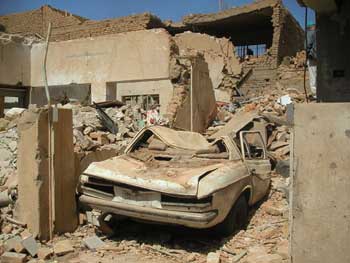
March 28th: Raytheon missiles strike at Al Sholeh district
Ikhlas Faiq, 25, who was treated later at the Al Noor hospital, recalls
"When the rocket came, the whole area became dark. For a few minutes I couldn't see a thing. When I opened my eyes, I saw bodies and parts of bodies everywhere I looked."11
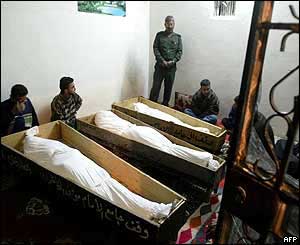
March 28th: The three boys of the Al-Hamdami family.
By late evening, 52 corpses passed through the al-Noor hospital. Even the battle-hardened doctors at Noor said this US attack marked a fresh descent into horror,
"There were limbs torn off, and burns, multiple shrapnel injuries, head and chest injuries....[doctor Tarif Jamil said] 'I saw about six children - all dead - and at least three women."12
Friday night, Navy commander Penfield was 'apparently still buzzing', saying "I can't sleep yet."
Buzzing and exhilarated.
On the cloudless, star-lit night of Baghdad, the wailing of women emanating from a poor house was a beacon of grief. Inside, a dozen Iraqi women clad in full-length, black cloaks sat huddled on the floor, bobbing back and forth and sending piercing, high-pitched screams into the night of Baghdad. They mourned the three boys - aged 12, 18 and 12 - of the al-Hamdami family.13
Exhilaration and soul-wrenching grief co-existed as the day of March 28th faded away.
"It was all nice and calm in the city..."
Earlier on Friday, two other U.S. "guided" projectiles landed in the Al-Mansour neighborhood of Baghdad, killing 8 and injuring another 33. Jo Wilding provided a first-hand account of what she saw on March 29th:14
- A U.S. missile hit the middle of Palestine Street just outside the Omar Al Farouk mosque at about 4:15 PM, just as people were leaving after prayers. Umar, a student at Rafidain College, fell. He had fragments of shrapnel about 3cm. Long removed from his liver and abdomen. Another U.S. missile hit 3 minutes later. Akael Zuhair was standing in front of his house opposite the mosque. He received 'liberating' shrapnel wounds to his left shoulder, left chest, right forearm and possibly a piece is lodged in his brain. No one could guess what the intended U.S. target was.
- On the 28th in the early AM, the El Alawiya communication tower was bombed and the Al Baya one was hit at 5 PM on the 29th. The effect of knocking out telephone was to delay patients reaching hospitals for treatment.
- A grain silo was the apparent target of a U.S. attack at 9 AM on Thursday, about 35 kms. south of Baghdad on the road to Wasit. Haitham Abid was driving a lorry when the missile landed close to the Grain Board building. His lorry crashed and the rear end caught fire. Abid's right thigh is badly broken.
Jo Wilding asks,
"Something is wrong. There are too many civilian casualties, too far from military targets, for all of these to be mistakes. Either they are hitting civilians on purpose, to whip up fear in the hope of spurring rebellion, or their weapons are not as precise as they say, in which case they are not suitable for use in an urban environment. There's no justification for using any weapons here, but if you cannot hit a military target without causing civilian casualties, you don't have the right to attack it."
Intermezzo #2. On Saturday, March 29th, Iraqi television showed Iraqi fishermen dancing on a downed U.S. Predator spy plane in Lake Habbaniyah.15 The $3.2 million contraption had been transformed into a floating dance hall.
On Saturday, U.S. pilots targeted Baghdad's local telephone system, destroying telephone exchanges like the Mimoun International Communications center.16 A target of military significance?
An Agence France-Presse journalist visited the farming community of Al-Janabiin [Janabiyah] on the southeastern edge of Baghdad. A night-time U.S. raid had destroyed three homes, killed 20 civilians [11 children, 7 women and two men].17

March 29th. A farm in al-Janabiin after a U.S. 'precision' strike.
A report describes the scene at Janabiyah, where U.S. 'precision' weapons hit: "Kids became 'human torches'."18
"Bloodied school books and children's shoes lie amidst animal carcasses on the road leading to the Ismail'a farm in this village...the main building of this hamlet, accessible via a checkpoint manned by militiamen, has been leveled, the second burned out and the third partially destroyed. A neighbor told an AFP journalist that two missiles fired by coalition warplanes on Saturday night caught five sleeping families on the farm. The raid left 20 people dead....littered amongst the rubble spread over the grass were carcasses of four cows, their eye, nose and mouth cavities blackened by swarms of flies. Two dogs, sheep and chickens lay motionless nearby. "Five children were turned into human torches in this house because of the gas cylinders inside," one of the survivors said, wondering how God spared him while four other family members were wounded. "Their bodies protected me because I was in a corner."
What might General Vincent Brooks have to say about how his precision missiles transformed five children into human torches?
Another 6 civilians were killed and six homes destroyed inside Baghdad in the al-Amin neighborhood in east Baghdad.19 The Al-Salehia Telecommunications Center of Baghdad was completely leveled by U.S. strikes on Sunday, March 30th. The magnitude of the destruction and the obviously injured persons are captured in the following photo:

That same day, U.S. bombs fell into the industrial neighborhood of al-Zafaraiya in southern Baghdad, killing another six civilians.
Intermezzo #3. The U.S. Navy has deployed a number of "marine mammal systems" to hunt down sea mines in the area of Umm Qasr in southern Iraq. At least two Atlantic bottle-nosed dolphins are [were?] taking part in Umm Qasr mission - Takoma and Makai. But, to the embarrassment of the Navy, Takoma went AWOL since the first mine-snooping mission. His handler, a dispirited Petty Officer Whitaker was seen patting the water, calling for him, and offering his favorite fish, to no avail.20
At 11 AM on Monday, March 31st , a U.S. bomb struck the dirt-poor Shiite Muslim neighborhood of Rahmaniya in Baghdad.21
A pre-dawn U.S. strike targeted the Iraqi Information Ministry, setting off fires in an adjacent shopping mall named after Saddam Hussein's birthday.22 Abu Dhabi TV showed live footage of the raging fire, which it said was in the ministry's press center. A Tomahawk missile had hit the Ministry building early Saturday morning, gutting one floor and destroying many satellite dishes on the roof. But, it had also demolished neighboring dwellings. Next door to the leveled telephone office in Baghdad's A'azamiah district, hit early Sunday morning, Adel Hussein al-Abdali, 70, told a crowd of journalists escorted to the site next to the Ministry,
"That Bush is a despicable coward. But we will be victorious with the help of God."
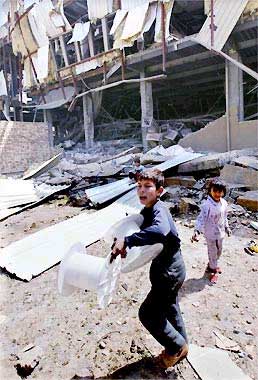
Dwellings next to the Information Ministry in Baghdad.
Metal boxes sprouting hundreds of telephone wires dangled precariously from the telephone building, along with lighting fixtures and office furniture. The Salhiya telephone was also destroyed by several missiles. Eight hours after the attack, the structure was still smoldering. The force of the U.S. attack there shattered the windows of the Saddam Center for Cardiac Surgery across the street. It damaged the house of Zeinab Fouad. Attacks upon civilian communications center - as in the Afghan invasion - are part of U.S. war plans.
U.S. bombing also hit a cooking gas cylinder-filling factory in the southern city of Qurnah on Saturday morning. The factory was located in a residential area of Qurnah, situated at the confluence of the Tigris and Euphrates rivers.
On March 31st, U.S. Marines in a Bradley fighting vehicle machine-gunned to death 11 Iraqi civilians at a U.S. Army check point on Route 9 near Najaf. The Iraqi family of 17 had left their village, packed into a 1974 Land Rover, wearing their best clothes for the trip through the American lines "to look American." At least seven women and children died in the assault on a vehicle filled with civilians - Bakhat Hassan, 35, said from his hospital bed that he lost 11 members of his family [two daughters aged 2 and 5, a son aged 3, his parents, two older brothers and their wives, and two nieces aged 12 and 15].23 His wife, Lamea, 36, who is nine months pregnant, said she saw her three children die, saying
"I saw the heads of my two girls come off. ...my girls, I watched their heads come off their bodies. My son is dead."24
"I watched their heads come off their bodies."
The captain in charge at the checkpoint, blamed his own troops for ignoring orders to fire a warning shot.
The grotesque? Listen:
Intermezzo #4. Some 15 vehicles including a minivan and a couple trucks blocked the road to the bridge in Nasiriya. The vehicles were riddled with bullet holes. Some had caught fire and turned into piles of black twisted metal. Others still burned. Mark Franchetti of The Times, counted 12 dead Iraqi civilians. The civilians had fled over the bridge and run into a group of shell-shocked young American marines. They fired. Corporal Ryan Dupre later expressed the satisfaction felt by some of his fellow marines. He said, "The Iraqis are sick people and we are the chemotherapy. I am starting to hate this country. Wait till I get hold of a friggin' Iraqi. No, I won't get hold of one. I'll just kill him."25
Kim Sengupta or the Independent visited Manaria, a dusty farming village in Mohammedia district, about 50 kms. south of Baghdad,26 where a U.S. missile fell on the dusty ground outside of 13-year-old Samar Hussein's home Saturday morning. It left a small crater and pockmarks of shrapnel damage scattered across the walls of her house and the family's battered Toyota Cressida. Samar's mother, Hamida, 40, had just told Samar not to go outside. Wiping her eyes with her black chador, Hamida recounted,
"She just fell. I could see blood coming from her stomach. She was gasping, and as I ran to her she was crying, 'Mama, Mama'....It was so terrible....There were others also hurt, and everyone was crying and screaming. We had to wait for a car because ours was so badly damaged. But I knew my Samar would not last until we got to the hospital. And that is what happened....she died in my arms..."
Hamida's voice faded away.
In the nearby village of Talkana, Amina al-Nimr, 68, lay on a string bed outside her home, her left leg and arm heavily bandaged. Kim Sengupta continues,
"She had been carrying bread back to the house where three generations of her family live when she was caught by the blast from an exploding missile. A 50-year old neighbor, Khursa Ali, was killed. "she was a young woman compared to me, and one of her daughters had just got married. But she died and I lived," said Mrs. Al-Nimr..."
U.S. projectiles hit a cluster of villages - Manaria, Zambrania and Talkana - surrounded by fields. They buried 22 people and now care for another 53.
"The dead from [both] villages are buried in desolate rows of graves, at the Haj Khudair cemetery, a garden of sand and mud. The newest grave, a mound of gray earth, is that of Samar Hussein. In the rows behind her are the rest of the dead brought in during the last fortnight, matching many of the names in the hospital's casualty list. Daoud, the cemetery's caretaker, was re-arranging some palm fronds covering the graves. "There have been more people buried here in the last two weeks than in the last two years. I knew some of them. They were killed by the Americans and the British. They all had simple ceremonies, because none of these people are rich..."
On the first day of April, another 66 - 81 Iraqi civilians were killed by American bombs and missiles. The following day, another 40 - 44 civilians were killed and over 200 injured. On April 3rd, air strikes in Baghdad killed 27 civilians and wounded 193 others.27 As the battle for Baghdad looms, the rate of civilian casualties rises - with 100 - 125 being killed just during the first two days of April 2003.
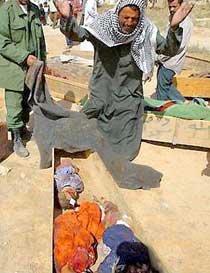
The Massacre at Hillah on April 1st.
U.S.-British cluster bomb assaults upon villages [e.g., Mazarek] around the city of al-Hillah in Babylon, around lunchtime on Monday, March 31st, killed another 48-60 civilians and wounded ~ 300 others.28 Dozens of homes were destroyed in the U.S. bombing that also killed donkeys and chickens. Khalid Hallil, 21, in Babylon General Hospital with a torn left thigh from knee to crotch from shrapnel, was inside his house three miles from the center of town. His father Hamid explains,
"Metal just came from everywhere. Believe me, there were no soldiers in the area. Only civilians. There was no reason for attacking us in our homes. Tell your countrymen what is happening here. Let them see with their eyes instead of listening to Tony Blair's lying words. Look, this is reality - not the make-believe world of Bush and Blair."29
Hamida Abed lost 15 members of her family when U.S. cluster bombs landed on her home. Reuters and Associated Press were permitted by Iraqi authorities to take their cameras into Hillah. The pictures showed babies cut in half and children with amputation wounds, apparently caused by American shellfire and cluster bombs.30 A 21-minute videotape was made, but was deemed too terrible to show publicly.
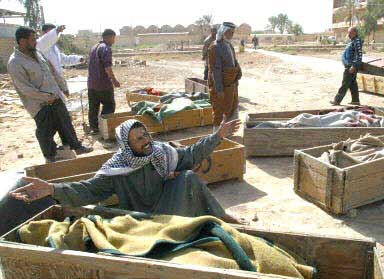
April 1st. The Massacre at Hilla near Babylon. An Iraqi man grieves over the body of his mother.
A bus was hit by tank fire near the city of al-Hillal in Babylon on April 3rd [photo below]. Basem Hoki, a 38-year old former construction worker, took a fateful bus ride south from Hillah on March 27th. In Hillah hospital with a left arm ending in a bloody stump, Hoki was one of only five survivors among the 35 in the bus. The Hillah hospital surgeon, Dr. Dhiya Sultani, said, "many of the people on the bus were decapitated."31
Nader, 5, and his mother had escaped the U.S. onslaught upon al-Hillah, which killed dozens of civilians. The next day, Nader went out to play. He stepped an American cluster bomblet. He was lucky, experiencing 'only' damage to his right eye.32
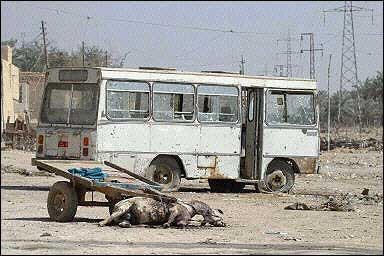
A U.S. Apache helicopter fired a rocket late Monday at the pickup truck of the al-Khafaji family in the area of Haidariya near al-Hillah, 80 kms. south of Baghdad. The family was fleeing the fighting in Nasiriyah. The father, the sole survivor, Razek al-Kazeem, lost 15 members of his family - his wife, six children, his father and mother, his three brothers and their wives.33
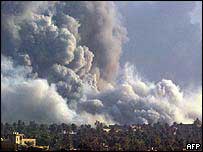
April 2nd. Baghdad Under Bombs [source: http://news.bbc.co.uk/2/hi/middle_east/2907835.stm]
Intermezzo #5. At 33,000 feet, a F/A-18E, Super Hornet pilot hears only his own breathing -- a complete disconnect between the carnage he creates on the soil below and his senses. On April 2, 2003, one such flyer, helmet in hand, with the hose from his oxygen mask draped around his neck like a scarf, was asked by a fellow pilot on the USS Abraham Lincoln, "hey, how'd it go? You Drop?" The answer, "Kaboom!" He hears nothing when his bombs explode, rarely even sees the blast. He lives in the virtual reality of psychic insulation. The men mostly in their late 20s and early 30s don't talk about killing. Lt. Stan Wilson 33, a barber's son from Iowa, said "we don't talk about it, don't worry about it. I don't know how this sounds, but we're more selfish than that. I worry about my car payments; the other guys worry about their girlfriends and wives." Kaboom! The pilots rationalized their rain of bombs by hiding behind the piety of 'precision bombing', seeking consolation by repeating this is not Dresden or Tokyo. Since only 85 Iraqi civilians died on April 2nd [Table 1], yes, this is not Dresden or Tokyo. Lt. Stephen Doyle, 29, reflected, "I have faith in the way we're doing things...I don't think that's deluding myself."
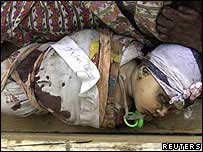
A child killed in massacre at al-Hillah in funeral shroud.
Robert Fisk reported on his visit to a 'ladies education agricultural college' on the outskirts of Baghdad on April 1st.34 A 20 foot crater from a U.S. projectile had disturbed the college lawn. Internal doors were torn from their hinges, desks overturned, beds thrown across rooms, but no one was hurt. Fisk found four black and white cows tethered in the grass, perhaps 10 meters from the crater. The Guardian's Suzanne Goldenberg reported that on Monday, March 31st, "a poor baklava seller, pitied by the entire neighborhood, lost his wife, mother, sister, nephew, and two sons to American bombs."35 She goes on to describe the day's happenings:
"..tragedy struck in Sueb [a suburb 35 kms. from the center of Baghdad] when US missiles killed six members of the family of the lowly baklava seller, Ali Abdul Rasul, and five others living in the same road. Twelve houses were destroyed in the blast, hastily built one story structures crumpled into the earth. 'The people living in the area are the very poorest people. It really is so cruel that we are being hit,' said Taliya Al Mohammed, whose house, down the road from Mr. Rasul's, was strewn with shattered glass."
The close proximity of the houses in Sueb magnifies the impact of America's "liberating bombs."
At 4 AM on April 2nd , after the children of Sueb had cried themselves to sleep, the US missiles destroyed two more homes,
"Leaving Mr. Hathem with few possessions beyond a kerosene cooker and a TV set. The entire clan felt the loss. ..."when the missiles came in, everything shook,' said Yas Khudayar, who shared a tunnel space of barely 2 square meters with a wife and five children. 'We expected to be dead any minute.' Next door, at Ms. Rah,an's house, the floors were carpeted with broken glass and chunks of plaster. Overhead fans were plucked from the ceilings like flowers. 'Just look at what those Americans have done,' she said. 'We hate them now more than ever. What have we done? Why should our children suffer? Saddam Hussein has not hurt us..."
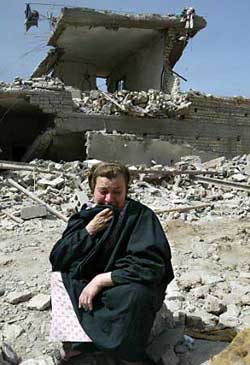
April 2nd: a U.S. 'precision' bomb hits the International Trade Fair building in Baghdad, and blast power destroys a maternity hospital across the street.
On the morning of April 2nd, the Basra Sheraton was hit by four heavy artillery shells. The hotel's only guests were al-Jazeera journalists.36 At 9:30 AM, U.S. aircraft fired projectiles into a complex of buildings in Baghdad's al-Mansour district, housing the International Trade Fair.37 The Trade Fair was built in 1954 as a symbol of Iraq's new nationhood and it once housed 1,000 companies from 60 nations.38 The target was a secret police station across the road from the hospital. But, the force of the explosions incinerated nearby cars, killed 3-10 civilians and wounded 25, and severely damaged a Red Crescent maternity hospital on the other side of the street [see photo above]. The hospital was renowned for providing a reliable service for those who could not afford the high fees of private clinics. The hospital's facade was destroyed as was its drug store. A ceiling in the waiting room had collapsed. A doctor said a total of ten patients and staff were injured at the hospital.39 The U.S. missiles obliterated wings of Baghdad's trade fair building which lies next to a government security office -- that was missed in the bombings. A foreign correspondent said that five burned-out and twisted cars halted in the middle of the road, with drivers burned to death inside. A Greek doctor who had just sat down at 9:45 AM on April 2nd , to talk with doctors at the Red Crescent hospital, was shaken by four U.S. bombs striking across the street, Dr. Dimitrius Mognie said,
"We all fell to the floor, and the glass windows shattered all over us."40
Two women in the room were hurt. Dr. Mognie commented upon how Baghdad hospitals were running out of supplies. Critical surgeries were being carried out with only very light anesthetics. Antibiotics and tetanus vaccines were running out.
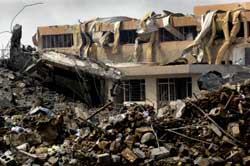
Bombed: Baghdad's International Trade Fair.
On Thursday, yet another 'smart' bomb struck a vegetable market at Nahrawan on the southeastern edge of Baghdad, killing eight civilians and injuring five more. Information Minister al-Shahhaf reported on Thursday that 27 civilians had been killed and 193 wounded in the U.S.-U.K. bombing of Baghdad on Thursday, April 3rd.42
On Friday morning, April 4th, the Khalaf family was getting up after a night of heavy bombardment. A correspondent of Britain's Daily Mirror recounted,
"And I shall try to write what he and his family said in exactly the order they said it. I shall try because I hope it will better convey the bewilderment and horror that broke on one Iraqi household yesterday...Both sisters [Nadia and Alia]...were still in their nightclothes, dressing gowns loose around them. They said they had risen late because of all the shelling overnight. Like everyone else, they were talking about the electricity being cut off on Thursday night. Nadia was joking about going for a shower. Alia told her she'd probably be away for three hours... just waiting for some water. They were laughing. "I didn't hear any sound," Alia says, "Suddenly a shell or bomb or something came through the room. I fell to the floor. My mouth was full of dust. I was swallowing dust. Then I looked at her."
"The missile, something big and unexploded, had come through her chest and her heart. She was covered in blood, unconscious. I ran down to the street, Daddy and Mummy behind me, screaming for an ambulance. There wasn't any. A neighbor said he would drive us here to the hospital. "We all knew it was too late. But we hoped, we hoped." Her father Najem Khalaf stood beside her corpse. ... "A shell came down into the room as she was standing by the dressing-table," Najem says. "My daughter had just completed her Ph.D in Psychology and was waiting for her first job. She was born in 1970. She was 33. She was very clever. "Everyone said I have a fabulous daughter. She spent all her time studying. Her head buried in books. She didn't have a care about going out enjoying herself. My other daughter is the same. She has a Master's degree in English and teaches at the university. Me? I'm just a lorry driver. A simple man." He holds out his dead daughter's identity card for us to see. His fingers are covered in her blood.."43
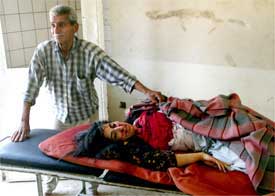
April 4th , Najem Khalaf weeps next to his daughter, Nadia, 33, killed by a U.S. missile [Photo Mike Moore, Mirror]
A litany of lies has spewed forth from U.S. and U.K. officialdom, whose intent appears to be to capture the headlines regardless of the substance said.44 The thinking is that the general public remembers mostly 'headlines', therefore priority must be to monopolize the headlines with claims [which later get retracted but at no political cost]. The following chart presents a brief, incomplete listing of such official lies:
| Date | Headline [date] | Truth [date] |
| March 23 | UK forces take the port of Umm Qasr [March 23rd] | On March 26th, UK forces still fighting in Umm Qasr |
| March 25 | UK asserts uprising of Shi'a in Basra | No uprising took place |
| March 26 | UK reports 120 tanks fleeing Basra | Later found three tanks had left Basra |
| March 29 | UK claims to have captured an Iraqi general | Retracted a day later saying he was only an officer |
| March 28 | Blair announces at news conference with Bush two UK soldiers had been executed | UK gov't later retracted the story saying they had died in combat |
| March 21 | US defense officials declare Iraqi commander of 51st Division in Umm Qasr had surrendered | He later appears live on Al Jazeera TV |
| March 29 | US asserts Iraqi anti-aircraft fire destroys al-Shu'la market killing at least 62 civilians | Robert Fisk shows part of US missile he found with markings that indicate it was produced in Texas by Raytheon |
The biggest official U.S. lie remains the constantly repeated claim - one endlessly intoned by the solemn US corporate media choir with solos sung by defense intellectuals - that unprecedented precision bombing is taking place in Iraq, bombing which largely spares civilians.
The mainstream corporate has, alas, once again blindly accepted Pentagon claims of 'precise' and 'surgical' bombing. After the first night of U.S. attacks NBC's Pentagon correspondent Jim Miklaszewski says "every weapon is precision guided - deadly accuracy designed to kill only the targets, not innocent civilians."45 The initial spin about 'deadly accuracy' would later give away to simply ignoring compelling evidence [from Britain] that the U.S. had bombed and killed many civilians, e.g., parroting the Pentagon claim of having no knowledge of the deadly attack on the al-Shu'la market.46 When U.S. Marines machine-gun Iraqi civilians at a checkpoint outside of Najaf, most of the mainstream U.S. media prefers the Pentagon's sanitized version.47
In point of fact, U.S. bombing during Iraq War II has to-date been over three times as deadly to civilians as that of Iraq War I, notwithstanding the dramatic use of so-called precision weapons:
| Civilians killed | Tonnage dropped | PGM share of total bombs | Civ/10,000 tons bombs dropped | |
| Iraq, 1991 | 3,000 | 88,000 tons | 6 percent | ~400 |
| Iraq, 2003, for March 20-April 1 | 650 | 4,600 tons | > 90 percent | ~ 1,350 |
Egypt's leading newspaper, Al-Ahram, said in an editorial on April 2nd, the 'clean war' has become the dirtiest of wars, the bloodiest, the most destructive. Smart weapons have become deliberately stupid, blindly killing people in markets and popular neighborhoods.48 The Red Cross said that its doctors who visited southern Iraq this week saw "incredible" levels of civilian casualties.49 A Red Cross spokesperson in Baghdad mentioned a truckload of dismembered women and children in al-Hillah. And as American tanks blasted their way into the western suburbs of Baghdad on April 5th, they pulverized more homes and a truck driver witnessed children 'flying in the air.'50
American tanks firing...and on the receiving end, Iraqi children flying in the air.
"It was all nice and calm in the city...[but] once those bombs hit all hell broke loose."
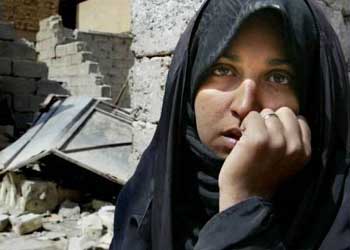
An Iraqi woman sitting in front of her house destroyed during U.S. strike on Baghdad, April 2nd [Reuters/Faleh Kheiber] Source: http://sg.news.yahoo.com/030402/3/39pxh.html
Table 1.
Civilian Casualties During First Two Weeks
of the U.S.-U.K.War in Iraq
| Day | Place | Civilians killed | Wounded | Weapon and commentary | Sources |
| Through March 27th | All Iraq | 350 | 4,000 | n.a. | Health Minister Mubarak51 |
| March 28 | Al-Nasser market in al-Shu'la,Baghdad | 55 - 68 | 50 | Raytheon rockets from plane devastates market area | BBC 3/28/03Guard 3/29/03Indep 3/30/03 |
| March 28 | Al-Mansour in Baghdad | 8 | 33 | 2 missiles in upscale residential area | MEO 3/28/03 |
| March 28 | Najaf | 26 - 35 | 60 | Cluster bombs hit city | IBC; Guardian 3/29/03 |
| Mar. 28-29 | Anbar | 28 | Air strikes | IBC | |
| Mar. 28-29 | Babel | 3 | Air strikes | IBC | |
| Mar. 28-29 | Karbala | 6 | Air strikes | IBC | |
| Mar. 28-29 | Baghdad | 6 | Air strikes | IBC | |
| March 30 | Zafraniya in so. Baghdad | 6 | Air strikes on industrial area | IBC | |
| March 30 | Manaria village, 50 kms. so. of Baghdad | 22 | 53 | Missile strike upon this farming village in Moohammedia district | Indep. 4/4/03 - K. Sengupta |
| March 2 | Nasiriya | 12 | US troops machine-gunned family on bridge | Times 3/30/03 - M. Franchetti | |
| March 31 | al-Amin Sueb district in e. Baghdad | 6 | Air strikes destroys 6 homes | AFP 3/31.03Guar 4/3/03 | |
| March 31 | Rahmaniya district, Baghdad | 2 | Kills 2 boys [14 and 16] | WP 3/31/03 - A. Shahdid | |
| March 31 | Najaf | 7 - 11 | Bradley tank fires at family in car | Reuters 3/31/03, Ananova 4/2/03 | |
| March 29 or 31 | al-Janabiin {Janabiyah] farming area s.e. of Baghdad | 17 - 20 | 10 | 2 missiles kill 20 [incl. 10 children] in farming comm. | News24 3/31/03, Albawaba 3/31/03, AFP 3/31/03 |
| April 1 | Outside Shatra | 1 | Machine gun | Guar 4/1/03 | |
| April 1 | Villages of Babylon and its capital, Hillah, 80 kms. so. of Baghdad | 11 - 33 | 400 | Cluster bombed this farming community at lunchtime. Red Cross reports on utter carnage. | Y!News 4/1/03, Guar 4/3/03, Mirror 4/3/03 |
| April 1 | Haidariya | 15 | Apache attack upon 15-member family in pickup | Y!News 4/1/03, ABC News [au] 4/2/03 | |
| April 1 | Baghdad | 6 - 18 | Bombs hit residential area | Y!News 4/1/03, MEO 4/1/03, IOL 4/1/03 | |
| April 2 | Central Babylon | 5 - 9 | 25 | AM air attack | derived |
| April 2 | Qadisayah and Salaheddin | 25 | 105 | Air attacks | Derived, Indep [4/2/03] |
| April 2 | Hit near to Red Crescent hospital, trade fair, Baghdad | 3 - 10 | 25 | 3 missiles shatter abandoned hospital, killing passersby. Target was Int'l Trade Fair bldg. across the street | Guar 4/2/03, Guar 4/3/03, Reuters 4/2/03, Mirror 4/4/03 |
| April 2 | Babylon, Muthena, and Ninevin in north | 14 | 100 | Air attacks | MEO 4/2/03 |
| April 2 | Al Jazeera offices hit in Basra | 0 | 0 | 4 heavy artillery shells strike Basra Sheraton | Guar 4/2/03 |
| April 2 | Bartalah, 11 kms. east of Mosul | 21 | 75 | B-52 bombing | IOL 4/2/03 citing Al Jazeera |
| April 2 | Saddam Canal | 1 | shot | Guar 4/3/03 | |
| April 3 | Vegetable mkt. on s.e. edge of Baghdad in Nahrawan | 8 | 5 | Missile hits market, kills 8 @ hospital sources | IOL 4/3/03Herald Sun 4/3/03; MEO 4/3/03 |
| April 3 | suburb of al-Doura | 14 | 66 | Missile or cluster bombs hit residential area in so. Baghdad | Reuters 2/3/03 citing al-SahafIOL 4/4/03 |
| April 3 | Mahmoudia district, 69 kms. from Baghdad | 5 | 55 | Cluster bombs | IOL 4/4/04 |
| April 3 | Baghdad area | 27-22=5 | 193-65=128 | Derived from Min. Al-Shahaf's totals for 4/3: 27 killed and 193 injured | MEO 4/3/03 |
| April 3 | Furad village near Baghdad airport | [83] | [120] | U.S. rocket and cluster bomb attacks in the PM Reports indicate dozens died, but some are military, more wounded | Reuters 4/3/03, Indep. 4/5/03 |
| April 4 | Checkpoint in s.e. Baghdad | 7 | Again, Marines fire at civilian vehicles, killing 7 [incl. 3 children] | ABC News 4/4/03 | |
| April 4 | Palestine Street, Baghdad | 1 | Nadia, 33, killed by projectile, hitting her home | Mirror 4/5/03 | |
| Subtotal: | All Iraq | 696 - 770 | n.a. | Derived from the above data | About 49-61 killed each day |
| est. total [incl. April 3rd] | All Iraq | 1,252 | 5,103 | Figure cited by Foreign Minister Naji Sabri | Reuters 4/4/03 |
Note : IBC stands for Iraqbodycount, at www.iraqbodycount.net.
-- 30 --
Footnotes
1. George Monbiot, "No Way Out," ZNet [April 1, 2003]
2. "Either Take a Shot or Take a Chance" The New York Times [March 29, 2003]
3. "When 'Precision' Bombing Isn't. Iraqi Civilians Learn the Lesson of Afghanistan" [dated March 29, 2003]
4. "Iraq: More Than 350 Killed in First Week of War," Middle East Online [March 27, 2003 at 12:14]
5. "US Pilots 'Bask in Glory' of Bombing Baghdad," Reuters [March 28, 2003 at 08:56 PM ET]
6. Rageh Omaar, "Market Horror Takes it Toll," BBC News [March 29, 2003 at 13"17 GMT], and "Many Dead in Baghdad Blast," BBC News [March 28, 2003 at 22:22 GMT] with photos. More stark photos.
7. See the daily updated "Shock and Awe" photo gallery, which contains dozens of evocative photos. Articles on the US bombing may be found at the site of U.S. Bombing Watch.
8. "De Plus en Plus de Victimes Civiles Irakiennes," Le Monde [2 avril 2003]
9. Craig Nelson, "Another Market, Another Blast and Iraqis Blame the US," Statesman.com [March 29, 2003]
10. "IPT Report: March 28th Bombing of Al Sholeh District of Baghdad," ElectronicIraq.net [March 28, 2003]
11. Suzanne Goldenberg, "52 Die in Baghdad Market Blast," The Guardian [March 29, 2003]
12. Goldenberg, op. cit.
13. Nelson, op. cit.
14. Jo Wilding, "I am His Mother" [datelined Baghdad, March 29, 2003]
15. "Iraqis Dance on Unmanned Plane Downed in Lake - TV," Reuters [March 29, 2003 at 14:21 GMT].
16. Robert Fisk, "Bombing of Phone System Another Little Degradation," The Independent [March 29, 2003]
17. "Twenty Civilians Killed When Raid Hit Farm," Yahoo!News [March 31, 2003 at 21:30 PM] citing AFP.
18. "Kids Became 'Human Torches'," News24 [South Africa] [March 31, 2003 at 19:36]
19. "26 Civilians Killed in Baghdad Bombing," Middle East Online [March 31, 2003 at 16:57]
20. Daniel McGrory, "Takoma the Dolphin is Awol," The Times [March 29, 2003]
21. from Anthony Shadid, "A Boy Who Was 'Like a Flower.' The Sky Exploded and Arkan Daif, 14, Was Dead," Washington Post [March 31, 2003], p. AO1.
22. Hamza Hendawi, "Airstrikes Target Iraq's Information Ministry," Associated Press {March 30, 2003]
23. "You Didn't Fire a Warning Shot Soon Enough!'," The Guardian [April 1, 2003]
24. "Survivors Describe Horror and Disbelief at US Checkpoint Shooting," Ananova [April 2, 2003 at 12:30]
25. Mark Franchetti, "US Marines Turn Fire on Civilians at the Bridge of Death," The Times [March 30, 2003]
26. Kim Sengupta, "Samar's Story," The Independent [April 4, 2003]
27. "U.S. Kills 27 More Civilians, Nowhere Near Baghdad: Iraq," Islam Online.net [April 3, 2003]
28. Detailed accounts may be found in Anton Antonowizc and Mike Moore [from inside Babylon General Hospital], "Bombs Fall on Babylon," The Mirror [April 3, 2003], and in Robert Fisk, "Wailing Children, the Wounded, the Dead: Victims of the Day Cluster Bombs Rained Down in Babylon," The Independent [April 3, 2003]
29. Antonowicz, op. cit.
30. Robert Fisk and Justin Huggler, "Children Killed and Maimed in Bomb Attack on Town," The Independent [April 2, 2003]
31. Robert Collier, "Hundreds in Iraqi Town's Hospital. Wards Filled With Many Civilians, Some Apparently the Victims of Cluster Bombs," San Francisco Chronicle [April 3, 2003]
32. "Iraqi Children Maimed at Play," Islam Online.net [April 2, 2003], with photo of Nader.
33. "48 More Civilians Killed South of Baghdad," Middle East Online [April 1, 2003 at 17:23]
34. Robert Fisk, "Cows and Armed Guards on A college Campus. Where is the Truth Amid All This Subterfuge?" The Independent [April 2, 2003]
35. Suzanne Goldenberg, "Poor Pay With Their Lives in Cratered Suburbia," The Guardian [April 3, 2003]
36. Jason Deans, "Al-Jazeera's Basra Hotel Bombed," The Guardian [April 2, 2003]
37. Simon Jeffrey and agencies, "Baghdad Hospital Bombed," The Guardian [April 2, 2003].
38. Anton Antonowicz, "Unreal City," The Mirror [April 4, 2003]
39. Samia Nakhoul, "U.S. Raid Hits Iraqi Hospital, Cause Casualties," Reuters [April 2, 2003 at 11:56 AM ET]
40. "Baghdad Doctors Low on Medical Supplies," The Guardian [April 5, 2003 at 7:30 PM]
41. "Missile Kills Eight Iraqi Civilians in Baghdad," Middle East Online [April 3, 2003 at 03:17]
42. "Iraq: 27 Killed in Bombing of Baghdad. Thursday," Middle East Online [April 3, 2002 at 13:57]
43. Anton Antonowicz, "The Saddest Story of All," The Mirror [April 5, 2003]
44. An interesting discussion about media disinformation may be found in Gregory Sinaisky, "Detecting Disinformation, Without Radar," Asia Times [April 3, 2003]
45. "Action Alert: 'Precise' and 'Surgical': NBC's Bombing Claims Lack Verification," FAIR Action Alert [March 26, 2003]
46. "Action Alert: Media Should Follow Up on Civilian Deaths: Journalist's Evidence That U.S. Bombed Market Ignored by U.S. Press," FAIR Action Alert [April 4, 2003]
47. "Action Alert: Official Story Vs. Eyewitness Account: On Najaf Killings, Some Outlets Seem to Prefer the Sanitized Version," FAIR Action Alert [April 4, 2003]
48. Michel Sailhan [Cairo], "TV Pictures of Civilian Casualties Heighten Arab Anger," Middle East Online [April 2, 2003 at 16:06]
49. "Red Cross Horrified by Number of Dead Civilians," Canadian Press [April 4, 2003]
50. Suzanne Goldenberg, "Amid the Casualties and Chaos, A Sudden Appearance by Saddam," The Guardian [April 5, 2003]
51. "Iraq Says Over 350 Civilians Killed, 4000 Injured in War," Peoples' Daily [English] [March 27, 2003]
